Turnaround soon for Mahaweli Authority
By Shirajiv SIRIMANE
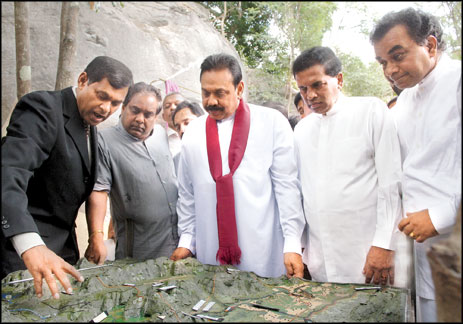
President Mahinda Rajapaksa inspects the model of the
Moragahakanda project |
Certain ministries and government institutions have been infamous for
posing a financial burden on the government coffers for many years and
eroding the profits generated by other ministries.
With sound economic management, this negative trend seems to be
changing, with some of these 'infamous' institutions slowly, but surely
showing signs of turning around.
Some key factors that had been common to all these loss-making bodies
are mismanagement, not tapping the resources within the institution,
over-staffing, lack of direction and heavy debts they have to pay other
bodies.
One such institution was the Mahaweli Authority which owns the
biggest land deposit in the country and accounts for the highest number
of power and irrigation projects. It is now planning to stop asking the
Treasury to fund its payroll.
"For years this has been the practice and we have been dependent on
the government for financial assistance," said Director General Mahaweli
Authority, D.M.C. Dissanayake.
|
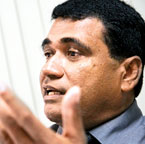
D.M.C. Dissanayake |
He said that he was ashamed to admit that the Treasury was paying for
their well-being while they have the ability and resources to turn the
Authority around to a profit-making venture.
He said Minister of Irrigation and Water Resources Management Nimal
Siripala de Silva too has realised their potential and is taking
meaningful steps to make the Mahaweli Authority a profit-making venture.
"One of the first things that we are planning to do is to give over
500,000 hectares of uncultivated land to the public so that they can be
cultivated," he said. This would be on a long-term lease and would range
from five acres upwards.
"This project is already under way and the response from the public
is overwhelming," he said.
Mahaweli, as a whole, is South Asia's biggest development project and
over a 25-year period since its creation Rs. 98 billion has been
invested on the project with both local and foreign funds. "One must
remember that this investment has been very prudent as it has generated
electricity to the value of Rs. 481 billion. The total power generation
of Mahaweli is 667 megawatts.
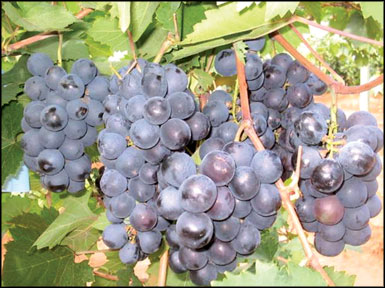
Grapes produced by Mahaweli farmers
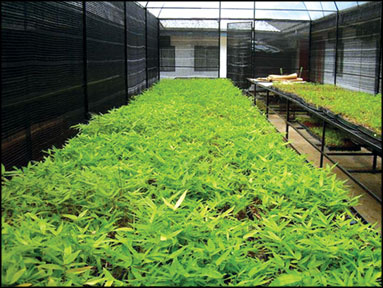
A green house farm
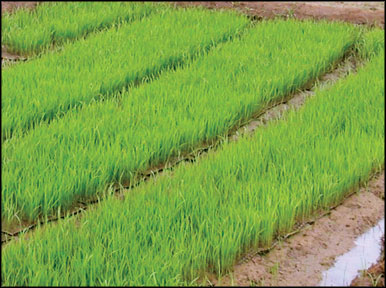
Paddy cultivation |
"It has also provided the nation with over Rs. 500 billion products
through agriculture and farming. There are over one million people who
depend on the Mahaweli movement.
"However, once again I like to stress that this is far below the
potential of the Mahaweli," Dissanayake said.
New power generation
Plans are under way to re-tap the Victoria reservoir to re-generate
electricity.
The Mahaweli Authority is now studying this proposal and the plan is
to generate around 210 megawatts from this new power project. "We are
hoping to use an additional turbine for this purpose," he said.
The Victoria Dam is the largest hydro power dam in Sri Lanka. Power
is generated by three 70 MW Francis turbines, totalling the installed
capacity to 210 MW, thus playing a significant role on the national
grid.
At a length of 520 m (1,706 ft), and a height of 122 m (400 ft), it
is also the tallest dam in the country and possesses the largest power
station as well. The dam is located across the Mahaweli River,
immediately upstream of the Victoria Falls.
Dissanayake said that this would be the first time in Sri Lanka that
water once used to generate electricity is being re-used.
The last Mahaweli project, the Moragahakanda Kalu Ganga project, is
also being constructed.
This is a multi-purpose project providing 30 MW of electricity and
drinking water.
One of the most important aspects of the project would be the
provision of water to farmers in the Eastern Province.
He said that paddy, farming, fruit and vegetables and poultry are
some of the key drivers in the Mahaweli Zone.
For the first time Mahaweli farmers introduced Sri Lanka's highest
prized mangoes to the local market and are now making plans to export
them to Europe and the Gulf. Branded as Tom EJC (Mangifera indicate) and
weighing over 500 grams this mango is to be prized at around Rs. 700 to
the local market and at around US $ 10 to the foreign market.
"We are also planning to grow 20 acres of Tom EJC in our new farm in
the Moragahakanda area from next month", he said.
The Mahaweli Authority is also looking at exporting fruits and
vegetables grown by Mahaweli farmers and hope to be the mediator in this
regard.
He said foreign investors too would be encouraged to invest in the
agricultures sector which would create a major positive impact on this
area.
"There is also a plan to manufacture chickenfeed," he said.
Providing cows to farmers is another project which would yield
long-term benefits. One of the other areas that are being concentrated
on is the inland fisheries sector.
"We have ample water resources for this venture and we are planning
to supply breeding fish to farmers," he said. They also plan to release
some of the fish to large reservoirs so that people could 'catch' them.
"We expect the future of this industry to be a major one where even
Mahaweli canned fish would be available for both local and foreign
consumption," Dissanayake said.
Development of tourism
He said the tourism potential in the Mahaweli Zone was never utilised
and this is an untapped gold-mine which they plan to use to the maximum.
He said that as an initial step they will allow seaplanes to land in
Mahaweli waters so that tourists could travel faster to their
destinations. SriLankan Airlines would be the key player in this
project.
Private companies too have expressed interest in this regard. Plans
are also under way to launch a boat service in the reservoirs which
would attract both local and foreign tourists.
The Ministry has earmarked Maduru Oya, Kotmale and Kalawewa for
tourism development.
"We plan to lease out land to the leisure sector so that they could
invest and develop these properties," he said. Dissanayake said that
they are expecting several star class hotels to come up in these areas
as they are ideal for eco-tourism.
This would generate employment opportunities and also stimulate
cottage industries in the area.
He said that they have a staff of over 5,000 and they have no plans
of retrenching them. "In fact, they are an asset to the organisation and
with the rapid development envisaged in the Mahaweli Movement down the
line, we would be able to give them salary increment and even a 'bonus'
would be on the cards.
"Most importantly, we want to provide revenue to the State and be a
productive and much talked about institution in the future, he said. |

